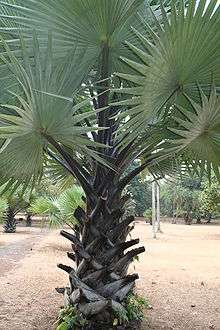Borassus aethiopum
Borassus aethiopum is a species of Borassus palm from Africa. In English it is variously referred to as African fan palm, African palmyra palm, deleb palm, ron palm, toddy palm, black rhun palm, rônier palm (from the French). It is widespread across much of tropical Africa from Senegal to Ethiopia and south to northern South Africa, though it is largely absent from the forested areas of Central Africa and desert regions such as the Sahara and Namib. This palm also grows in northwest Madagascar and the Comoros.[2][3]
| Borassus aethiopum | |
|---|---|
 | |
| Scientific classification | |
| Kingdom: | Plantae |
| Clade: | Tracheophytes |
| Clade: | Angiosperms |
| Clade: | Monocots |
| Clade: | Commelinids |
| Order: | Arecales |
| Family: | Arecaceae |
| Genus: | Borassus |
| Species: | B. aethiopum |
| Binomial name | |
| Borassus aethiopum | |
| Synonyms[1] | |
Description
The typical form of Borassus aethiopum is a solitary palm to 25 metres (82 ft) in height and 1 metre (3 ft 3 in) in diameter at the base. In the river bottoms (floodplains) of many East African rivers (the Rufiji in Tanzania and the Tana in Kenya among others) a closely related form can be up to seven feet (2.1 meters) thick at breast height (4 feet (1.2 meters) above ground) and having the same thickness in its upper ventricosity. It also has a height of up to 100 feet (30.5 meters)[4][5][6] The fan-shaped leaves are 3 metres (9.8 ft) wide (larger, to 12 feet (3.66 meters) in the bottomlands form) with petioles 2 metres (6 ft 7 in) long; the margins are armed with spines. In male plants, the small flowers are largely concealed within the scaly catkins; the much larger female flowers reach 2 centimetres (0.79 in) wide and produce yellow to brown fruits. Each fruit contains 1-3 seeds, each enclosed within a woody endocarp.[7] The floodplains variety is almost certainly the most massive of all palms.
Uses
The tree has many uses: the fruit are edible, as are the tender roots produced by the young plant;[8] fibres can be obtained from the leaves; and the wood (which is reputed to be termite-proof) can be used in construction.[9]
See also
- Great Mosque of Djenné (example of use of wood in construction)
References
- The Plant List, Borassus aethiopum Mart.
- "World Checklist of Selected Plant Families: Royal Botanic Gardens, Kew". apps.kew.org. Retrieved 2017-08-01.
- AFPD. 2008. African Flowering Plants Database - Base de Donnees des Plantes a Fleurs D'Afrique.
- Dr. Al C. Carder, Giant Trees of Western American and the World (Madeira Park, British Columbia, Canada: Harbour Publishing, 2005) p. 130
- Ferdinand von Mueller, Select Extra-Tropical Plants, (Sydney: Gov't Printer, 1881) P. 50. Quoting: Lt. Col. James A. Grant and Daniel Oliver, The Botany of the Speke and Grand Expedition (London: R. Taylor, 1875)
- Reinhard Kunkel, Elephants (New York: Harry N. Abrams Inc. Publishers, 1982) Color Plate pp. 100-101 Adult elephants give size comparison. Caption (p. 242) mistakenly calls these "oil palms".
- Bayton, Ross P. (2007). "A revision of Borassus L. (Arecaceae)". Kew Bulletin. 62: 561–586.
-

- Bailey, L.H. & E.Z. Bailey. 1976. Hortus Third i–xiv, 1–1290. MacMillan, New York.
External links
| Wikimedia Commons has media related to Borassus aethiopum. |
- Horticopia page on B. aethiopium
- PACSOF page on B. aethiopium
- La Plant Encyclo page on B. aethiopum (in French)
- Multilingual Multiscript Plant Name Database page on Borassus
- Borassus aethiopum in West African plants – A Photo Guide.
- "Borassus aethiopum". Ecocrop FAO. Archived from the original on 2011-07-26. Retrieved 2010-02-08.